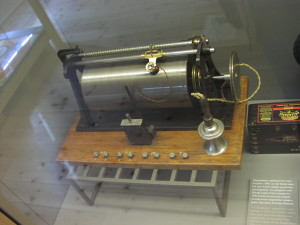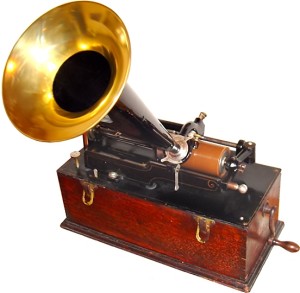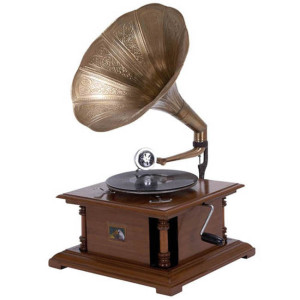Who isn’t familiar with the picture of the dog focused on the phonograph horn listening to the voice of his deceased master? Such is the power of sound, especially familiar sounds.
While typing this post, I was listening to the incredibly beautiful work of music by Ralph Vaughan Williams, entitled “The Solent”. Prior to 1877 such would not have been possible. For in that year, Thomas Edison invented the phonograph and within decades home entertainment was revolutionized. The piano in the parlor began to collect dust and piano lessons began to become a thing of the past.
Edison’s machine used a needle to record little hills and valleys in a wax cylinder, which when played back produced sound. In 1887, Emile Berliner patented the gramophone which used a flat disc. The needle followed a track with moved side to side instead of up and down.
Below is Edison’s phonograph from 1899.
Eventually Berliner’s gramophone won the commercial battle because the process of producing records instead of cylinders was cheaper. A record cost 20¢, whereas a cylinder cost 50¢. For the cost of 2 cylinders, I could buy 5 records. Pretty simple math and the cylinder became a footnote in history. Ironically enough, Edison had already contemplated the disc but favored the cylinder because it was scientifically more perfect. I guess even geniuses make mistakes. And that’s why many of us grew up collecting records instead of cylinders.
Below is picture of a wind-up gramophone.
Edison’s phonograph was the first machine to both record and playback sound. However, an earlier machine, the phonautograph, invented in 1857, made a visual image of the voice for study by doctors and scientists. The image could not be played back. At least not until 2008 when, with the help of optical scanning and computers, the pictures were turned into digital audio files and listened to for the first time. The oldest recordings of the human voice.
Just as Bell had competition for the telephone, so did Edison with the phonograph. That competition came in the form of Charles Cros’ paleophone. Cros, who was a poet and amateur inventor, came up with the idea to use photoengraving to transfer the phonautograph image to a disc or cylinder for playback. He wrote a letter describing his idea and deposited it with the French Academy of Science on 30 April 1877. Cros’ idea became public on 10 October 1877, however by then he had improved upon his original concept by inventing a way to capture and record sound using an acid-etch method.
Learning of Edison’s machine, Cros had his April letter opened and claimed scientific priority over Edison.
Cros’ method became standard procedure to produce the metal masters from which the flat records could be pressed. Unfortunately, he died in 1888 and could not enjoy his triumph over Edison. Today, no one’s even acquainted with the name of Charles Cros.
The phonograph, or gramophone, is perhaps one of the most iconic inventions of The Machine Age. Rivaled only by the telephone and the automobile. It appeared at the age’s beginning and was going strong when the age faded away. Today, the phonograph has morphed into the ubiquitous iPod.
There was a gramophone on board the Graf Zeppelin on its round the world flight in August 1929. Brought on board by millionaire Bill Leeds, Commander Hugo Eckener had it promptly removed. Leeds retrieved the machine and told Eckener if weight was the problem he’d leave behind his luggage.
Bram Stoker, in his novel Dracula, had Doctor Seward record his diary on a phonograph. Seward, however, was worried the count might be able to melt the wax cylinders with his mysterious powers and destroy Seward’s recordings of the vampire’s machinations. That is perhaps the first literary example of the dictaphone, which has also gone digital.
Of equal lineage with the phonograph is the tape recorder. We don’t really use them anymore but we do use digital versions to record our voices.
The tape recorder was invented in 1886 by Alexander Graham Bell’s Volta Laboratory. The machine used a strip of paper coated with beeswax. Magnetic recording was first conceived of in 1877 and demonstrated in 1898, first using wire and later tape.
Below is an early magnetic wire recorder from 1898.

The record player and tape recorder were everywhere in the 20th century — even more widespread than the TV. I think retro-futurist writers with a little imagination can easily come up with something true to form and yet truly fantastic. Bram Stoker did so simply by including a phonograph in his novel. Now what if that record player or tape recorder could fit inside a small brown box about the size of a deck of cards?
Share This!
